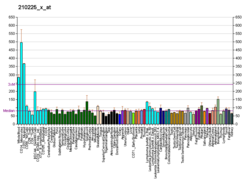| LILRB3 |
|---|
|
| Identifiers |
|---|
| Aliases |
LILRB3, CD85A, HL9, ILT-5, ILT5, LILRA6, LIR-3, LIR3, PIRB, PIR-B, leukocyte immunoglobulin like receptor B3 |
| External IDs |
OMIM: 604820 MGI: 1195974 HomoloGene: 134028 GeneCards: LILRB3 |
|
|
|
|
| Wikidata |
|
Leukocyte immunoglobulin-like receptor subfamily B member 3 is a protein that in humans is encoded by the LILRB3 gene.
This gene is a member of the leukocyte immunoglobulin-like receptor (LIR) family, which is found in a gene cluster at chromosomal region 19q13.4. The encoded protein belongs to the subfamily B class of LIR receptors which contain two or four extracellular immunoglobulin domains, a transmembrane domain, and two to four cytoplasmic immunoreceptor tyrosine-based inhibitory motifs (ITIMs). The receptor is expressed on immune cells and is believed to be a myeloid checkpoint. It is thought to control inflammatory responses and cytotoxicity to help focus the immune response and limit autoreactivity. Multiple transcript variants encoding different isoforms have been found for this gene.
See also
Further reading
-
Kimura K, Wakamatsu A, Suzuki Y, et al. (2006). "Diversification of transcriptional modulation: large-scale identification and characterization of putative alternative promoters of human genes". Genome Res. 16 (1): 55–65. doi:10.1101/gr.4039406. PMC 1356129. PMID 16344560.
-
Sloane DE, Tedla N, Awoniyi M, et al. (2004). "Leukocyte immunoglobulin-like receptors: novel innate receptors for human basophil activation and inhibition". Blood. 104 (9): 2832–9. doi:10.1182/blood-2004-01-0268. PMID 15242876.
-
Tedla N, Bandeira-Melo C, Tassinari P, et al. (2003). "Activation of human eosinophils through leukocyte immunoglobulin-like receptor 7". Proc. Natl. Acad. Sci. U.S.A. 100 (3): 1174–9. Bibcode:2003PNAS..100.1174T. doi:10.1073/pnas.0337567100. PMC 298746. PMID 12529506.
-
Strausberg RL, Feingold EA, Grouse LH, et al. (2003). "Generation and initial analysis of more than 15,000 full-length human and mouse cDNA sequences". Proc. Natl. Acad. Sci. U.S.A. 99 (26): 16899–903. Bibcode:2002PNAS...9916899M. doi:10.1073/pnas.242603899. PMC 139241. PMID 12477932.
-
Wende H, Volz A, Ziegler A (2000). "Extensive gene duplications and a large inversion characterize the human leukocyte receptor cluster". Immunogenetics. 51 (8–9): 703–13. doi:10.1007/s002510000187. PMID 10941842. S2CID 20719684.
-
Borges L, Hsu ML, Fanger N, et al. (1998). "A family of human lymphoid and myeloid Ig-like receptors, some of which bind to MHC class I molecules". J. Immunol. 159 (11): 5192–6. PMID 9548455.
-
Suzuki Y, Yoshitomo-Nakagawa K, Maruyama K, et al. (1997). "Construction and characterization of a full length-enriched and a 5'-end-enriched cDNA library". Gene. 200 (1–2): 149–56. doi:10.1016/S0378-1119(97)00411-3. PMID 9373149.
-
Cella M, Döhring C, Samaridis J, et al. (1997). "A novel inhibitory receptor (ILT3) expressed on monocytes, macrophages, and dendritic cells involved in antigen processing". J. Exp. Med. 185 (10): 1743–51. doi:10.1084/jem.185.10.1743. PMC 2196312. PMID 9151699.
-
Samaridis J, Colonna M (1997). "Cloning of novel immunoglobulin superfamily receptors expressed on human myeloid and lymphoid cells: structural evidence for new stimulatory and inhibitory pathways". Eur. J. Immunol. 27 (3): 660–5. doi:10.1002/eji.1830270313. PMID 9079806. S2CID 2212182.
-
Maruyama K, Sugano S (1994). "Oligo-capping: a simple method to replace the cap structure of eukaryotic mRNAs with oligoribonucleotides". Gene. 138 (1–2): 171–4. doi:10.1016/0378-1119(94)90802-8. PMID 8125298.
External links
This article incorporates text from the United States National Library of Medicine, which is in the public domain.
|
|
|---|
| 1–50 |
|
| 51–100 |
|
| 101–150 |
|
| 151–200 |
|
| 201–250 |
|
| 251–300 |
|
| 301–350 |
|





